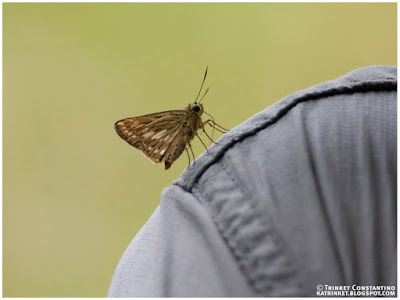A morning in Antipolo...
Midway through December last year, Adri and I took a short trip east of Manila to Rizal to visit our friend with a lovely home and garden, teacher Emma. It is always a delightful visit, to sit down with her over a leisurely breakfast and talk about this and that in the world while surrounded by greenery and beautiful things.
Before leaving (our morning visit had lasted until noon - as good conversation always makes us lose track of the time), we took a short walk down her street and came across a few birds.
A Philippine Pygmy Woodpecker was keeping busy up a huge rain tree, together with several Lowland White Eyes, a migrant Arctic Warbler, a few Gerygones and a pair of Pied Fantails.
Further down, we spotted a White-throated Kingfisher and a few Philippine Bulbuls. A Grey backed Tailorbird called loudly from the tangle of vines and bamboo while an invisible Mangrove Blue Flycatcher sang melodiously. Above us a Philippine Serpent Eagle circled twice before gliding gracefully over the hill.
Back at the gate of the house, Yellow-vented Bulbuls and Red-keeled Flowerpeckers were gorging on the the bubbly white fruit of a small tree.
I've seen this tree in thickets here and there but never found out what it was. I asked help online and one of the suggestions was Dalunot, Pipturus arborescens.
What I always thought of as its flowers, were actually its fruit! The small, soft, white and fleshy fruit looked to me like thick soapy foam bubbles and the birds love it!
The red-keeled flowerpecker we were busy observing was no exception. I was happy to find out that it was a native plant. (Please do correct me if the identification is wrong!)
Right above us a Philippine Coucal was skulking in the thick vines. How wonderful to be in a place where the birds do not seem so afraid of humans!
On to Angono...
Since we were already in Rizal and we had the whole day free, we decided to drive further and check on the family of Philippine Eagle Owls at the Angono Petroglyphs.
When we got there, we were delighted to here the news from the curator Roden that the young owl had just fledged that morning! We quickly spotted him quietly perched in front of the cave wall.
We spent a good hour on the viewing platform for the petroglyphs chatting with Roden talking about the owls, the museum, and of course, the state of the nation. Such serious topics! All the while a pair of tiny Scaly-breasted Munias were busy with their nest just above the cave.
Life seems so fleeting when standing before a centuries-old testament to history.
Life seems so fleeting when standing before a centuries-old testament to history.




















































